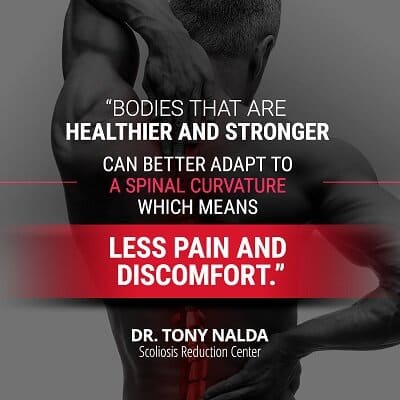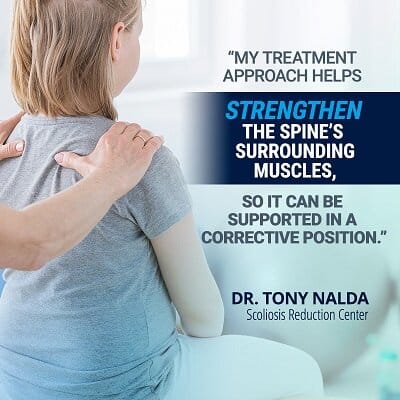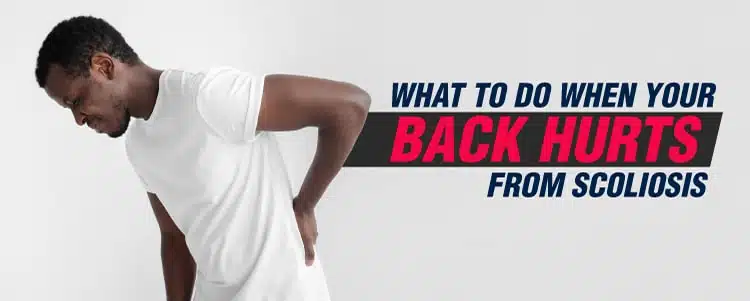People with scoliosis suffer from varying degrees of pain based on a number of factors such as their age, fitness level, and the severity of their condition. Fortunately, there are a number of non-surgical ways for people with scoliosis to manage their pain.
Understanding Scoliosis
Scoliosis is a complex condition characterized by an abnormal curvature of the spine. It can be classified into different types, including idiopathic scoliosis, degenerative scoliosis, and congenital scoliosis. Idiopathic scoliosis is the most common type, accounting for up to 80% of scoliosis cases, and its cause is unknown. Degenerative scoliosis, on the other hand, is caused by the wear and tear of the spine over time, often due to age-related degeneration. Understanding the type and severity of scoliosis is crucial for developing an effective treatment plan.
Living with Chronic Back Pain
No one wants to live with pain, nor should anyone have to. The sad reality, though, is that many people live with diseases and conditions that make pain a part of their daily lives.
When people struggle with pain, the regular aspects of life that bring them pleasure can fall by the wayside. Priorities can change from living and enjoying life to simply trying to manage the pain and get through the days.
People with scoliosis deal with varying degrees of pain. While many cases of spinal deformity affect people more so in functional ways, scoliosis-related pain can be a very real issue. In addition, significant degenerative disc disease can exacerbate scoliosis-related pain, particularly in older adults.
The first thing I will say is that if you are experiencing pain with your scoliosis, it means something should be done. Every scoliosis case is different and so the pain-management needs and strategies will differ. Depending on the size of the curvature and its location, your doctor will have different advice on what types of exercise, etc. are appropriate for your individual condition.
Scoliosis and Pain
Experts have assigned three severity levels to scoliosis: mild scoliosis, moderate scoliosis, and severe scoliosis. This designation is based upon the patient’s degree of spinal curvature, measured by what’s known as a Cobb angle.
A Cobb angle measurement is taken with an X-ray and records the degree to which the spine deviates from a straight alignment. Generally speaking, the more severe the spinal curvature, the greater the likelihood is that the patient will experience pain as a result.
Scoliosis-related pain is complicated and has no easy fix. Living with a progressive condition means treatment will often follow a two-pronged path: one that focuses on managing the symptoms of the condition and the other that focuses on slowing or stopping the condition’s progression.
When to Seek Medical Attention
If you or your child is experiencing any of the following symptoms, it is essential to seek medical attention:
- Uneven shoulders or hips
- A visible curve in the spine
- Back pain or discomfort
- Numbness or tingling in the legs
- Difficulty walking or standing
Early detection and treatment can help prevent complications and improve treatment outcomes. If you notice any of these symptoms, consult with a healthcare professional for a proper diagnosis and treatment plan.
Diagnosis and Treatment
Diagnosing scoliosis typically involves a physical exam, medical history, and imaging tests such as X-rays, MRI, or CT scans. The severity of scoliosis is measured by the Cobb angle, which reflects the degree of spinal curvature. Treatment options vary depending on the severity of scoliosis and may include:
- Observation: Regular check-ups to monitor the progression of scoliosis
- Bracing: Wearing a scoliosis brace to prevent further curvature
- Physical therapy: Exercises and stretches to relieve pain and improve posture
- Surgery: Spinal fusion or other surgical procedures to correct the curvature
In some cases, scoliosis surgery may be necessary to correct severe curvature or relieve pressure on the spine. Spinal fusion is a common surgical procedure that involves fusing two or more vertebrae together to stabilize the spine.
Scoliosis Surgery as a Remedy for Pain
Many people who suffer from scoliosis-related pain choose spinal-fusion surgery out of fear. Some think it might be the only option to alleviate their pain, or they feel surgery is a preemptive strike against increasing pain levels associated with aging.
I respond to these concerns by pointing out to my patients that surgery is neither their only, nor their best option. While surgery can be successful in terms of making the spine straighter, it can have a big cost in terms of flexibility, functionality, and overall body health. Often, pain at the fusion site or infection can also be prevalent and lead to further complications and subsequent surgeries.
Surgeons do their very best to minimize negative outcomes and surgical side effects, but the bottom line is that spinal-fusion surgery is costly, invasive, and has the potential to affect the body in numerous negative ways.
Scoliosis-Related Pain and Where it Shows Up
surprises a lot of people is that scoliosis can cause pain in a number of other places as well.
In addition to back pain, scoliosis symptoms can include headaches, neck pain, and discomfort in other areas of the body.
Specifically, in cases where the spinal curvature is in the upper back, patients can experience a lot of tension headaches. Anyone who has ever struggled with bad headaches knows how debilitating they can be. Scoliosis-related tension headaches can also reach migraine status.
For those who haven’t experienced a migraine, they can be agonizing and are often accompanied by a loss of vision, numbness and tingling throughout the body, or particularly down one side, nausea, sensitivity to light, movement, sound, and crippling pain.
Scoliosis is also known to lead to a decreased flow of cerebrospinal fluid which can further exacerbate the frequency and severity of headaches.
In addition to back pain and headaches, there are a number of other areas of the body that experience scoliosis-related pain:
- Nerve pain
- Neck pain
- Hip pain
- Leg pain
- Knee pain
- Muscle pain
Additional Scoliosis Side Effects
The key to managing scoliosis-related pain is to be proactive. The traditional approach to treating scoliosis, especially if first diagnosed as mild or moderate, involves a lot of observation. Often, treatment isn’t initiated until the curvature reaches severe levels or there is a rapid progression.
Not only can initiating early treatment slow or stop the condition’s progression, it can also be hugely beneficial in terms of managing pain and other scoliosis-related symptoms.
If scoliosis is left untreated, it is likely that one or more of the following negative side effects can also become an issue:
- Issues with digestion
- Bad posture
- Balance and equilibrium issues
- Decreased organ function (more so in severe cases)
- Low bone density
- Decreased oxygen intake
Age and Scoliosis Pain
Every patient has their own unique set of symptoms and strategies for managing those symptoms. In addition to the curvature’s severity, there is another crucial factor that impacts the level of pain in my patients: age.
Even individuals with milder scoliosis can experience significant discomfort, particularly as they age.
There is a lot of mystery that still surrounds scoliosis. A lot of that mystery resides around causation as 80 percent of diagnosed scoliosis cases are classed as idiopathic. ‘Idiopathic’ means having no known single cause. Within that group, the majority of those cases are classed as ‘adolescent idiopathic scoliosis’, and this is where age and pain become relevant.
Adolescent Scoliosis and Pain
Adolescents with scoliosis experience pain very differently from adults with the condition. The most common age of diagnosis is between 10 and 18 years of age. This age group experiences the most rapid phase of growth, known as puberty. During this stage, the body is constantly growing and changing.
While the body is growing, the spine is experiencing an upward growth motion as the body is elongating. That upward growth is why adolescent scoliosis patients report very little, if any, pain.
Adult Scoliosis and Pain
Obviously, adulthood is marked by a lack of growth. Once growth and that lengthening motion stops, scoliosis-related pain expresses itself more aggressively.
As spine curves develop or worsen with age, they can lead to increased pain and functional limitations. As the lengthening of the spine is replaced by compression of the spine, that compression places pressure on the spine and its surrounding nerves and tissues. The discomfort and pain can become debilitating and worsens with age, especially if left untreated.
Remedies for Scoliosis Pain
Here at the Scoliosis Reduction Center®, we’ve learned a lot about the power of scoliosis-specific chiropractic treatment and pain management. Not only does our chiropractic-centered treatment approach have positive results in terms of managing the condition’s progression and achieving a reduction, it also provides our patients with a lot of relief and helps restore function.
Exercise

Firstly, I have to remind people that no exercise regimen should be adopted without first speaking to your doctor; that being said, exercise has huge benefits for people with scoliosis, which is why it’s such an integral part of our functional patient-centered treatment approach at the Scoliosis Reduction Center®.
Bodies that experience movement regularly are healthier in general. They are more flexible, adaptable, and have stronger muscles and musculoskeletal systems. Bodies that are healthier and stronger can better adapt to a spinal curvature, which means less pain and discomfort. Low-impact exercises such as swimming, walking, and cycling help keep the muscles strong to help support the spine and keep the body flexible so it can better handle the spinal curvature.
Let’s not forget about the proven benefits that regular exercise has on overall health and wellness. Having a healthy mindset cannot be understated for anyone, but especially for those dealing with the added challenge of living with a progressive condition like scoliosis.
Stretching
Stretching seems like a simple thing, but it can have huge benefits when it comes to managing scoliosis-related pain. Spinal curvatures lead to tightness and decreased flexibility, which leads to pain. As the muscles on one side of the body tighten to compensate for the curvature, the person will experience that feeling of tightness and discomfort as a result.
Stretching reduces that tightness and helps keep flexibility and range of motion as functioning as possible. Stretches help those tight overcompensating muscles to relax, which gives my patients a huge amount of relief.
Chiropractic-Centered Treatment Approach
As my chiropractic-centered treatment approach focuses on increasing functionality, that increase in functionality means helping my patients retain as much flexibility and range of motion as possible.

As mentioned above, a lot of the pain and discomfort that affects my patients is the result of tight muscles that are overcompensating for their spinal curvature. Our scoliosis-specific chiropractic care focuses on strengthening those muscles so they are better able to deal with the curvature and less likely to stiffen and seize.
My treatment approach helps strengthen the spine’s surrounding muscles so it can be supported in a corrective position while providing relief as those muscles are relaxed and flexibility is maintained.
Not only has this approach shown remarkable achievements in terms of slowing or stopping the condition’s progression and achieving a curvature-reduction, it also happens to provide my patients with huge pain-relief benefits which greatly impacts their quality of life.
Lifestyle Changes for Scoliosis Pain Relief
Making lifestyle changes can help alleviate scoliosis pain and improve overall quality of life. Some recommended changes include:
- Exercise: Regular exercise, such as yoga or Pilates, can help strengthen the back muscles and improve posture
- Posture correction: Maintaining good posture can help reduce pressure on the spine and alleviate pain
- Weight management: Maintaining a healthy weight can reduce pressure on the spine and joints
- Stress reduction: Stress can exacerbate scoliosis pain; practicing stress-reducing techniques such as meditation or deep breathing can help
In addition to these lifestyle changes, a scoliosis treatment program may include physical therapy, pain management, and other therapies to address the underlying cause of scoliosis pain.
Post-Surgical Care and Recovery
After scoliosis surgery, it is essential to follow a post-surgical care and recovery plan to ensure a smooth and successful recovery. This may include:
- Rest and relaxation: Avoiding strenuous activities and getting plenty of rest to allow the spine to heal
- Pain management: Following a pain management plan to alleviate post-surgical pain
- Physical therapy: Gradually increasing physical activity and exercises to strengthen the back muscles and improve posture
- Follow-up appointments: Regular follow-up appointments with a healthcare professional to monitor progress and address any concerns
By following a post-surgical care and recovery plan, individuals can minimize the risk of complications and ensure a successful recovery from scoliosis surgery.
Conclusion
It can be difficult to know what to do when your back hurts from scoliosis. When my patients come to me with complaints of pain, I do my very best to provide them with strategies and methods to manage that pain. Fortunately, it just so happens that a huge part of my functional patient-centered approach marries two aspects of treatment: managing the condition’s symptoms and slowing/stopping the condition’s progression.
Once we have tackled the structural issue of the curvature, I work closely with my patients to come up with a treatment plan that incorporates exercise, stretching, and scoliosis-specific chiropractic care. These treatment areas offer my patients a sustainable form of pain management that also benefits the overall condition.
Surgery is not the only way to manage scoliosis pain, and especially for my older patients, managing increasing scoliosis-related pain as they age is a real concern. My approach to treatment is multifaceted and has seen impressive results that give my patients an effective and appealing alternative to spinal fusion surgery that can be invase to undergo..





